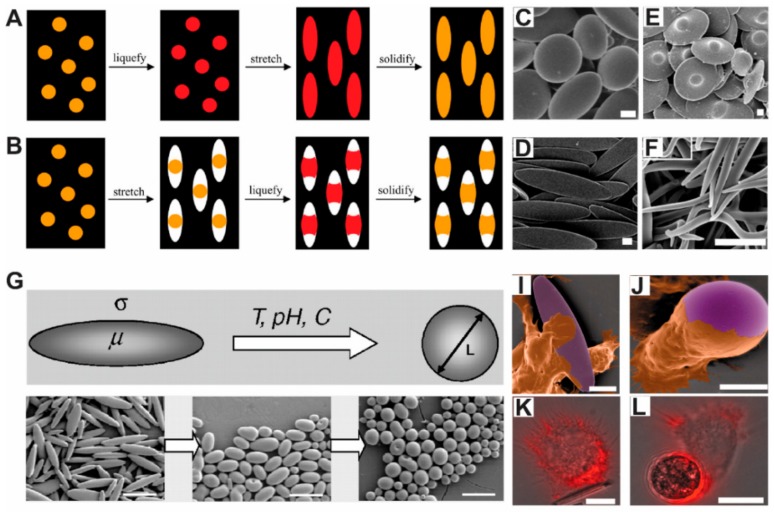Figure 6.
Mechanical stretching techniques were used to produce micro/nanoparticles for delivering therapeutic cargos. This group of techniques can be classified into two methods: (A) In the first method, thermoplastic spherical particles (i.e., polystyrene or PLGA) were embedded in a thin film of PVA. The particles were liquefied by heat or organic solvent, followed by stretching the PVA film with mechanical forces to create extra space, where the liquefied materials will fill in the space. Last, a cooling step was used to solidify the particles [83]. Copyright (2007) National Academy of Sciences; (B) In the second method, the PVA film embedded with thermoplastic particles was first stretched to generate some extra space for the particles, followed by liquefying the particles with organic solvent or heat to fill into the space. Particles were solidified by evaporating the solvents or lowering temperature [83], with copyright permission from © (2007) National Academy of Sciences. These techniques can generate particles with variable shapes such as (C) disk shape; (D) disk shape with a dot in the center; (E) elliptical shape; and (F) needle shape [83]. with copyright permission from © (2007) National Academy of Sciences; (G) Researchers studied the major factors that affect particle shapes including heating temperature, pH and particle viscosity and cooling speed [82], with copyright permission from © (2007) National Academy of Sciences. Using these particles, the researchers illustrated the impact of shape on the internalization of particles by macrophages. Artificially color-enhanced mages of macrophages internalizing (I) elliptical and (J) spherical shape particles. Fluorescence microscope showing the internalization of (K) elliptical and (L) spherical particles by macrophages [20], with copyright permission from © (2006) National Academy of Sciences. This study illustrated that the contact point between particles and macrophages will affect the internalization speed, where macrophages take up spherical particles more easily than elliptical particles of similar diameter.

